5358
Audio-motor interactions during musical playing with an external timing reference1Institute of Biomedical Engineering, National Taiwan University, Taipei, Taiwan, Taipei, Taiwan, 2College of Humanities and Social Sciences, Taipei Medical University, Taipei, Taiwan
Synopsis
Previous studies have demonstrated brain activation patterns during musical playing. However, while musical playing with multiple sources of auditory inputs is essential for musical practices and group performance, it is less understood. By using an MR-compatible piano keyboard, the present study compared musical playing with or without acoustic feedback or external timing reference. Functional MRI contrasts showed BOLD signal increase in bilateral Superior Temporal Gyrus and BA 42 during musical playing with an external timing reference, which indicates a neuronal processing pattern relating to the coordination of multiple auditory inputs.
Purpose
Playing music requires motor control with high temporal precision1, which is based on fast feedforward and feedback interactions between the motor and the auditory areas2,3. Specifically, feedforward processes are related to motor planning and execution to generate expected acoustic outcomes4,5, while feedback processes are related to precise motor controlling based on the discrepancy between the expected and the actual auditory outcomes6.
In group performances, an external timing reference, e.g. metronome, is essential for each member of a band to synchronize with the other players. Based on the audio-motor interaction model shown in Figure 1, playing the same melody with different acoustic inputs may involve identical feedforward but different feedback mechanisms. The feedback mechanisms involved under different auditory conditions are shown in Figure 2. When an external timing reference is available, the discrepancies between the external reference and expected acoustic outcome are explicitly fed back to the player to improve motor precision and the discrepancy between the external reference and the actual acoustic outcome is also important for feedback control. The present study aims to demonstrate the brain regions involved in the feedback control with external timing reference.
Method
All data were acquired on a 3T MRI scanner (Skyra, Siemens, Erlangen, Germany) with a 32-channel head coil array. BOLD signals were measured by an EPI (FOV: 224 × 224 mm2; resolution: 3.5 mm isotropic; TR = 2000 ms; TE = 30 ms; flip angle = 90o). Anatomical images were acquired using a T1-weighted MPRAGE pulse sequence. We designed an MR-compatible piano by modifying a plastic melody horn (SUZUKI, MELODION, MX-37C) and integrated a Bluetooth module (AIROHA, Bluetooth HID, AB1112A; Figure 3). To verify the image quality in the presence of the MR-compatible piano, the time-domain signal to noise ratio (tSNR) maps were calculated from EPI time courses. Figure 4 shows the tSNR ratio over a reference tSNR value. We recruited 17 subjects (10 females; 21.5 ± 1.5 years) with basic piano skills. They were asked to play the first 15 segments of the first portion of Sonatina Op. 36, No. 1 by Muzio Clementi using the MR-compatible piano inside MRI. Subjects played the music at a constant tempo of 90 beats per minute (90 BPM). The total playing time was 20 seconds. There were four experiment conditions. The first condition had no audio output from the piano (None), which was taken as the case without any audio-motor interaction. In the second condition, players only heard the sound of a metronome (M), which provided the external timing reference. In the third condition, players only heard the audio output of the piano (P). Players heard both metronome and piano output in the 4th condition (MP). Four seconds of metronome beeps were presented to players to notify the beginning of piano playing, which was followed by a 20-s silent resting period. Piano performances were recorded. Trials with unacceptable accuracy were excluded from analysis.Results
Figure 5 shows the contrasts of four conditions. Contrasting between M and None conditions revealed significant BOLD signals at bilateral Superior Temporal Gyrus (STG) in the temporal lobe and BA 40 in the left parietal lobe. Contrasting between MP and P conditions demonstrated larger brain activity distribution area at bilateral STG and bilateral BA 42 in the temporal lobe. Both contrasts demonstrated similar BOLD signal patterns at bilateral STG in the temporal lobe, but the MP vs P contrast shows more distributed brain activation volume.Discussion
In the present study, subjects were required to play the same melody under different auditory input conditions, which involved different feedback processes. As shown in Figure 2, contrasting between M and None conditions reveals brain region involved the feedback control after the comparison between the expected acoustic outcome and the external timing reference. While contrasting between MP and P also showed this feedback control, it specifically elucidated brain regions involved in the feedback control based on the discrepancy between the actual acoustic outcome and the external timing reference. Compared to the M vs. None contrast, the MP vs P contrast shows more distributed brain activations, which may be associated with feedback control based on the discrepancy between the external timing reference and the actual acoustic outcome. Overall, we show that playing music with an external timing reference may induce more distributed activations in brain regions responsible for multiple sources of auditory feedback control.Acknowledgements
This work was partially supported by Ministry of Science and Technology, Taiwan (103-2628-B-002-002-MY3, 105-2221-E-002-104), and the Academy of Finland (No. 298131).References
1. Zatorre, R.J., J.L. Chen, and V.B. Penhune, When the brain plays music: auditory-motor interactions in music perception and production. Nat Rev Neurosci, 2007. 8(7): p. 547-58.
2. Baumann, S., et al., A network for audio-motor coordination in skilled pianists and non-musicians. Brain Res, 2007. 1161: p. 65-78.
3. Furuya, S. and J.F. Soechting, Role of auditory feedback in the control of successive keystrokes during piano playing. Exp Brain Res, 2010. 204(2): p. 223-37.
4. Pearce, M.T. and G.A. Wiggins, Auditory expectation: the information dynamics of music perception and cognition. Top Cogn Sci, 2012. 4(4): p. 625-52.
5. Sammler, D., et al., Syntax in a pianist's hand: ERP signatures of "embodied" syntax processing in music. Cortex, 2013. 49(5): p. 1325-39.
6. Jancke, L., The dynamic audio-motor system in pianists. Ann N Y Acad Sci, 2012. 1252: p. 246-52.
7. Meister, I.G., et al., Playing piano in the mind--an fMRI study on music imagery and performance in pianists. Brain Res Cogn Brain Res, 2004. 19(3): p. 219-28.
8. Baumann, S., et al., A network for sensory-motor integration: what happens in the auditory cortex during piano playing without acoustic feedback? Ann N Y Acad Sci, 2005. 1060: p. 186-8.
9. Bangert, M., et al., Shared networks for auditory and motor processing in professional pianists: Evidence from fMRI conjunction. Neuroimage, 2006. 30(3): p. 917-926.
Figures
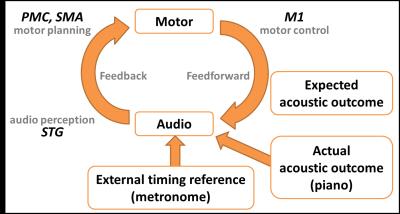
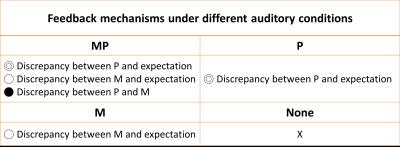
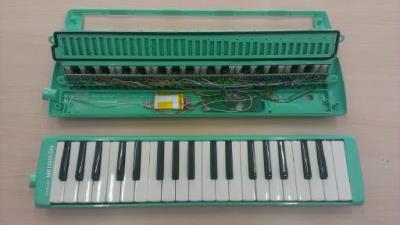
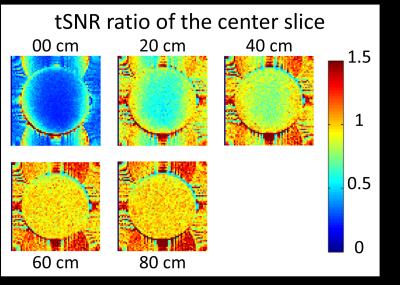
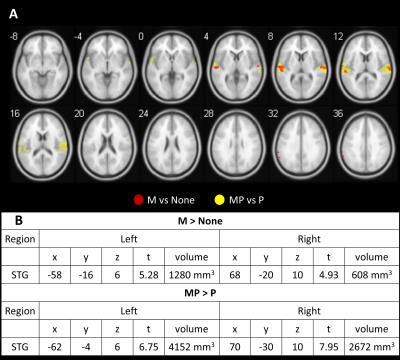
(A) M vs None: Bilateral STG in the temporal lobe and BA 40 in the left parietal lobe. MP vs P: Bilateral STG in the temporal lobe and bilateral BA 42 in the parietal lobe. The paired t-test threshold was taken as a cluster size = 5 and uncorrected p < 0.005.
(B) The volume size of STG in both contrasts with peak coordinates and t-test value.